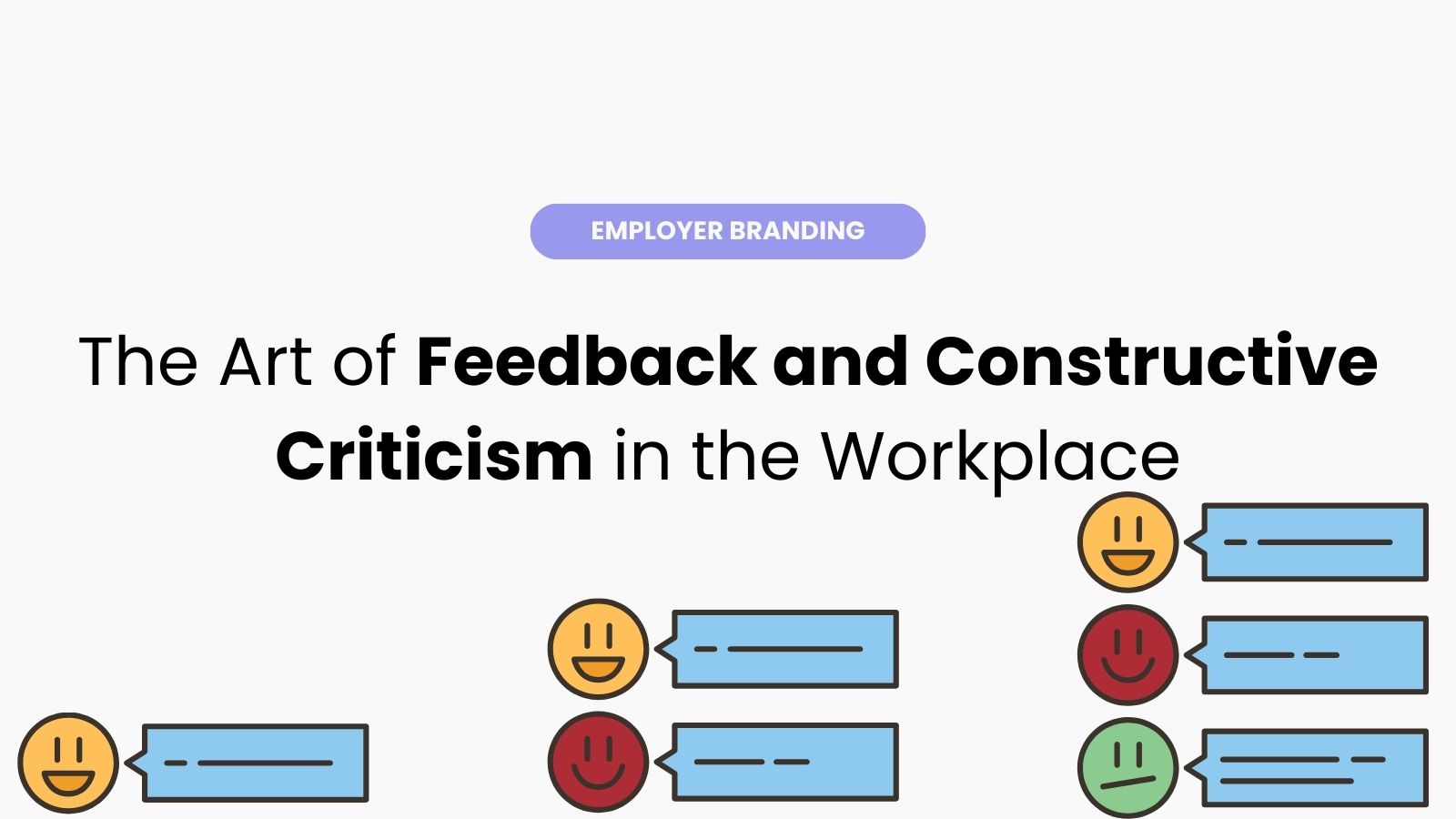Quality business communication among all teams is a key factor for the successful development of projects and overall business success. This communication spans all stages of employment, starting from the job application process, progressing through the initial steps of interviews, and extending to the final employment and regular interaction with colleagues. In this text, we will delve into the art of providing feedback and constructive criticism in the business space. This practice not only motivates each employee to give their best but also fosters satisfaction while working with other colleagues in the collective. Consequently, public opinion highly values quality and detailed feedback from a company.
Understanding the Power of Constructive Criticism
As previously mentioned, the power of constructive criticism is fundamental to maintaining a healthy business environment. Every company, guided by employers and HR teams, must recognize that feedback serves as the initial impression of the company itself and acts as a reflection that influences potential employees. To ensure objective assessments of everyone’s work and contributions within the company, proper structuring is essential. This involves identifying individuals responsible for specific activities within each project and outlining general responsibilities for each employee. The work process is a philosophical concept that demands clearly defined goals and the structuring of teams so that each member becomes a vital link in the business chain.
Simultaneously, each employee must uphold responsibilities towards others, clarifying who forwards completed tasks to whom and by what criteria. It impacts the Employee Experience, which is the intricate tapestry woven from the threads of employees’ thoughts, observations, and senses, narrating their journey through every stage of organizational existence. Now, let’s explore the understanding of constructive criticism. It requires a profound comprehension of the field, from theoretical concepts and agreements to interpreting the final result of the work and assessing its alignment with the envisioned outcome. Every response to a given topic should entail some level of criticism. It is crucial to provide both positive and negative feedback to the employee. Negative feedback doesn’t necessarily denote something negative; rather, all feedback should be approached with a positive mindset.
Constructive criticism should be detailed, extending beyond a few sentences. It should be direct, enabling the employee to clearly understand which aspects of their work align perfectly with the company’s expectations and where improvements can be made. This type of feedback naturally leads to another detailed meeting where these topics are discussed thoroughly, ensuring clarity and mutual agreement for further implementation.
In summary, mastering the art of constructive criticism entails educating and creating awareness within the team responsible for evaluating employees’ knowledge and performance. This team must be self-critical to manage the process effectively, ensuring that the results are positive and team-oriented above all.
Who is Expected to Provide Feedback?
In well-structured business forms, the evaluation process is transparent. The company is divided into teams, each with its structure within the business hierarchy. In specific projects, such as those in software development companies, each project often features a new scrum master, project manager, or a similar position ultimately responsible for the project’s successful implementation. The project leader must possess a thorough understanding of the habits and knowledge of other team members. As the captain, they are tasked with leading the team to present itself in the best light to clients.
It is crucial to define the project’s goal, break it down into manageable parts, and distribute tasks in proportion to the capabilities of the team members. With a well-organized division of tasks, setting deadlines becomes necessary to avoid last-minute implementations, allowing time for optimization and maximum efficiency. The project leader is accountable to superiors and, most importantly, to clients who have requested specific work. They must heed criticisms from clients, adopt them, and then communicate these insights to the team.
However, the leader should not simply transfer responsibilities to individual team members. Instead, they should distribute responsibilities correctly and proportionally, assigning new tasks to the team without overburdening any one individual. Clarity regarding responsibilities, tasks, and work is crucial, and monitoring progress should be constant but without undue pressure. It is essential to stay informed about the portions of the project completed within a given week or day, particularly as the project nears its conclusion.
When is the Moment to Criticize and Give Feedback
The timing of providing feedback is one of the most critical components. Criticism should not be abrupt and sudden, as it indicates that the person offering the criticism may not have thoroughly considered or understood the essence of providing feedback. Feedback should be gradual and accompanied by mutual understanding and communication. This is particularly crucial in full-time jobs, where employers must carefully assess the importance of each employee.
Beyond ensuring that employees feel comfortable with their team and colleagues, employers need to actively engage in interpersonal relationships. The HR team plays a vital role in introducing new employees to the company’s rules and policies, while also clarifying their responsibilities to the rest of the team. HR’s responsibility is to monitor employees’ work, acting as an ear in a complex interpersonal system. Their task is to find a harmonious approach that addresses everyone’s needs.
It is considered unprofessional to avoid providing any criticism and then suddenly deliver negative feedback without critical awareness. Unfortunately, we witness instances where companies dismiss employees abruptly, without fostering any interpersonal connections, and such actions do not align with a policy that would leave a positive impact on the community.
It is not Only the Superior Who Should Criticize
In a healthy and professional collective, it is reasonable for all participants in the business to have the right to speak and express their opinions that contribute to the company’s development. This brings us to the crucial point that every team member has the democratic right to criticize, even their superiors if they believe their approach is inappropriate or could diminish the enthusiasm and energy of the rest of the team.
Once again, the role of the HR team becomes evident, as they are responsible for monitoring relations and the overall atmosphere, enabling them to influence the creation of the most harmonious workplace environment.
The Difference Between Constructive Criticism and Negative Feedback
In the previous section, we outlined the fundamental definition of criticism and emphasized its essentially positive nature. Conversely, negative feedback stands apart from constructive criticism, and its quality has the potential to induce discouragement and negative feelings. Negative feedback is often terse and expressed in an unnatural language, intended to dismiss the business abruptly. Such feedback is highly detrimental, affecting both the company’s reputation and the internal morale among employees. In any situation, feedback should not merely be a brief written “rejection” but must comprehensively detail the reasons for dissatisfaction.
Inconcise Negative Feedback and the Absence of Feedback as the Worst Practice
Due to the sheer volume of work, HR teams often find themselves lacking the time to provide high-quality and concise feedback. However, this is not an excuse. Every company is obligated to elucidate all processes that pertain to them specifically. A prominent example of this occurs when individuals apply for a position in a company and await feedback regarding whether they will progress further in the process or face rejection.
Often, such systems are ambiguous, leaving applicants uncertain about when they can expect feedback, and, unfortunately, it frequently arrives later than initially communicated. However, this isn’t the primary issue. The most unprofessional aspect is the complete absence of feedback, leaving applicants without any communication after investing their time. Many companies have faced severe criticism for this practice in recent times, prompting increased attention to providing feedback in all cases. It must be acknowledged that the influence of the internet community has significantly contributed to this change, as workers rightfully voice their concerns and publicly share their experiences with various companies.
Receiving Feedback and Constructive Criticism Gracefully
Now, let’s discuss how the party receiving constructive criticism should react. It’s crucial to perceive criticisms as opportunities for self-improvement, even if they may not be as flattering as one would prefer. At the very least, consider them as valuable insights, allowing you to understand how your work is perceived and viewed from various angles. It also serves as a practical space for learning social psychology. Every interaction and communication with different structures within the company provides an excellent opportunity for introspection and learning how to approach things. While this advice pertains to receiving criticism in the business world, it often depends on the individual’s character. We are all different, and everyone accepts others’ opinions differently, which is entirely normal.
On the other hand, reacting violently to received criticism is never a good practice. Instead, it is rational to analyze criticism from all sides and explore the best possibilities to adapt to the feedback received.
Cultivating a culture of constructive criticism in the business world is essential. It represents an innate human virtue that contributes to the normalcy and health of a collective. In a world of mass employment, fostering such a culture becomes even more critical.




